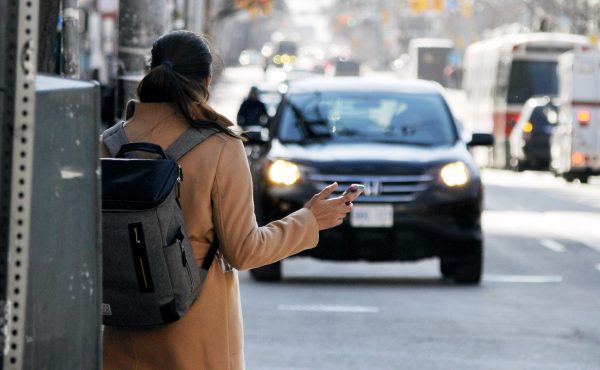Chief Building Official V. Ann Borooah presenting the City staff report on the Billboard Tax this morning.
Two hundred. Thirty-seven. Eight million. Six thousand forty-six.
I just made these numbers up. Pulled them out of the air. They represent nothing. Or maybe there’s a very particular system I used to arrive at and generate each, but I won’t tell you what that is.
The billboard industry does the same thing, except they commission expensive reports based on such numbers [PDF]. The Out-of-Home Marketing Association of Canada — composed of heavyweights Pattison, CBS, Astral, and Titan, as well as a handful of smaller companies — is hilarious. Here’s the standard exchange their representatives have with Councillor Adam Vaughan and just about anyone else with the ability to think critically:
OMAC: “The proposed tax on billboards represents an unfairly large portion of our revenue.”
Vaughan: “Can we see your revenue numbers so that we can figure out what an appropriate tax rate would be?”
OMAC: “No.”
Vaughan: “Well, will you disclose those numbers to an independent third party who will keep them confidential?”
OMAC: “No. But we have this other aggregate number that we can give you instead.”
Vaughan: “Can we see how you got that number?”
OMAC: “No. We’re telling you. That is the number.”
And on and on and again and again. For about five hours, the most recent time. They’re shocked that anyone wouldn’t take them at their word.
IllegalSigns.ca has been debunking OMAC’s claims all year. So have the sharper councillors. And now thankfully City staff have joined the chorus.
Councillor Joe Mihevc, indicating the downward trajectory of City’s staff’s tax projections over the past several months.
Ad companies used to be able to get away with telling City staff whatever they wanted. (“You need 20 years to make back your money on street furniture? Then a 20-year contract it shall be!”) But now they’ve encountered a dilemma. City staff are not only asking questions but follow-up questions. They don’t just want to know what the numbers are, they want to know why the numbers are. And if the ad industry’s paper doesn’t offer any sources then, well, they get a failing grade.
OMAC’s whole campaign, and the majority of their lobbying, is based on this report the association commissioned last spring. Back then, City staff were proposing a tax that would bring in at least $16 million (one estimate, using the bids for the street furniture contract as a gauge of how much the industry could afford, had the tax bringing in upwards of $56 million a year). The tax that’s currently before Council, however, would bring in $10.4 million a year. So OMAC’s conclusion that the industry will horribly suffer is based on a tax that is 54% greater than the one actually being proposed.
Second, the industry’s numbers were made up, or if they weren’t, they may as well have been. City staff note [PDF, page 18] that “The OMAC Study provided no verifiable data or a method that could be utilised to review the accuracy of the revenue and earnings information provided.” Nor are the numbers “consistent with the published rates for outdoor advertising in Toronto, or the rents received for advertising structures on City property.” Basically, the industry whines (and sometimes openly heckles) staff and councillors, saying you just don’t understand us. But when they’re actually asked to explain themselves, they steadfastly refuse to do so.
City staff, regardless of what the industry claims, have done their due diligence and analyzed every bit of actual, verifiable data they can get their hands on: the 33 billboards for which the City of Toronto is the landlord receiving rent from an ad company, the bids for the Coordinated Street Furniture Program, the advertising on the Sheppard line, and most importantly, the companies’ own CARD rates. CARD is Canadian Advertising Rates and Data, the Rogers-published directory of advertising rates across all media; it’s mostly available as a paid-access online database but also comes out in an annual print edition. (If you’re a current university student or faculty, there’s a good chance you can log in through the website of your school’s library.) City staff used CARD information and then discounted all of the numbers by 30% to account for periods of vacancy (i.e. when a sign isn’t rented) as well as the markdowns that the companies frequently offer their clients. This 30% number is what the industry told City staff in their consultations, and staff checked it against the City’s own leasing data.
Given everything the City has been able to determine about the billboard industry, the tax works out to 4.7—7.37% of a company’s revenue. This is approximately the equivalent of the GST, which hardly seems to have had any negative effect on the industry in the nearly nineteen years since it was introduced. (For that matter, it’s also smaller than the percentage that the price of a Metropass is going to increase next month.)
“Saying that information is inconsistent is not saying it is false,” a commenter on IllegalSigns.ca grumbles. “The only rebuttal [the City has] is a professor and city staff who are not even familiar with the industry.”
Well, yes. And here we see what the industry has been attempting to do all along. They’ve essentially offered City staff what they see as an ultimatum: either trust the scant numbers we’re showing you or face accusations of willful ignorance. City staff, to their credit, have not bought into this and have stuck to their own analyses, confident that they’ve done as good a job as anyone can while being stonewalled by an industry that of course does not want to be taxed.
(David Amborski, by the way, is the economics professor whom the City hired, and pages 22-23 of this PDF comprise his own analysis and dismissal of the OMAC report.)
What it’s going to come down to at Council today is whether city councillors have more faith in their own staff or in the industry that’s held them in such contempt for decades.
Watch the online stream, come out to City Hall, or follow the #TOcouncil hashtag on Twitter. The debate will likely go on all day.
Jonathan Goldsbie is a campaigner with the Toronto Public Space Committee.






21 comments
The city itself sets the bar very low when it comes to quality of research. Where was/is the due diligence in formulating the resting tax ratios in the ETBC program? It was pulled from a hat, despite having a much larger significance for Toronto.
In this case the city did do a good job in attempting to ascertain revenues and impact. It would be nice to see this replicated elsewhere.
I suspect many city councillors of both sides of the aisle would be nervous if pulling figures and “facts” out of your ass was banned.
I’m really annoyed by a billboard at College and Dufferin that states something like “The City’s Billboard Tax – Yet Another Tax We Don’t Need.”
It seems to me like they’re trying very hard to imply that the Billboard tax is something that will be paid by the populace, not the billboard companies.
Crimson – I saw that same billboard (near Danforth and Greenwood) for the first time this morning and it made me gag. I think what it actually says is “Yet Another Tax We Can’t Afford”.
As you rightly point out, the billboard industry is trying to feed off public resentment towards other recent new city taxes (land transfer, car ownership, plastic bag) and trick people into believing that the billboard tax will somehow affect their pocketbook.
If anything shows the true nature of that bottom-feeding industry, those signs are it.
I think the city should double – no wait, TRIPLE the tax they were contemplating just for the hell of it.
The public won’t give a shit about the poor billboard folks, especially if they see it keeps their property tax down.
Go for it!
Hahaha. How on earth in this day and age can OMAC think and expect city council or people in general to just “trust” them on their numbers when evidence thus far suggests they are sneaky and untrustworthy?
I have two of those billboard tax signs on either side of my block.
Thank You Councillor Norm Kelly for bending over and letting the industry shove…………you get the idea right? You want to cut the tax in half? As an artist you have stabbed me in the back. As a fellow Scarborough citizen, you have stabbed me in the back. As someone who voted for you in the past few elections……YOU HAVE STABBED ME IN THE BACK!.
Does someone have a band-aid for my back?
As much as I agree with taxing billboards, and with a stricter regulatory regime that would ensure compliance with an updated by-law, I’m a little uneasy about earmarking the money for the arts. If the arts needs money, let’s write it as a budget line item, not as a special conduit from a certain tax. What happens if ad rates plummet, for example?
As for the ETBC program: Glen do you have evidence that those resting tax rates were pulled out of thin air?
@JohnDoe – motorists got taxed and their tax didn’t get dedicated to roads or even to transit to free up the roads. Your histrionics will no doubt be a comfort to those city staff who will be forced to cover for colleagues “gapped” because the billboard tax won’t be directed to help bridge next year’s budget deficit.
I’m not necessarily against a new tax on billboards… but with all the needs the City is facing vis a vis its current needs (social housing, welfare caseload, parks and rec, etc.), why should it automatically go to arts programs? I’m not saying it shouldn’t go to arts programming, but I don’t see why the arts community should jump to head of the line just because it happened to cook up this scheme. These are two separate issues (taxing billboards and more arts funding) and should be dealt with as such.
samg> In Toronto the arts have been in line a long, long time. Check the per capital funding levels here vs other big cities. There was no line jumping.
@ Shawn – To the untrained eye, all of the “Live with Culture” things would seem to have made it to the front of the line a while back. I have no idea how all of that is paid for (much of it from private donors?), but I think people can be forgiven for wondering “why arts” here.
So, why arts?
Piping the revenue from a billboard tax into the arts is a decent basis for a claim that this amounts to internalizing the visual pollution (an externality) involved in “out of home” (ha!) marketing. Long live Pigou!
… But I might be biased. I named my cat after Pigou. So, yeah.
Shawn – that might well be so but directed funding should have had public hearings, not a bunch of facebook and twitter shout-outs. I would much prefer arts funding be found in the general budget so that there is direct accountability to property tax payers. However, that would involve finding savings in the existing budgets to allow expansion of arts funding.
My view on this is based on this article’s premise that at a time when existing programs are being cut you don’t expand into new areas:
http://www.thestar.com/News/GTA/article/587633
Billboard taxation is a “sin tax” – if the new bylaws result in a reduction in the number of billboards (through progressive elimination of legal non-conforming from sites being developed, for example) is the arts community going to be happy to take a reduction in the amount granted?
Greg> Live w Culture funded a bunch of things (a couple of my projects included) and get the sexy articles and was a good start.
Mark> The folks behind the billboard tax used FB as a tool sure, but they’ve been working on this for a few years now, and your underestimating the amount of old fashioned organizing they’ve done. Their coalition stretches across the city/class/race more so than any other I’ve seen in a long time.
You are correct, Mark, that the potential volatility of this revenue stream means that it would likely not not be an appropriate long-term source for the bulk of arts funding from the City; however, it does not follow from that conclusion that it is not appropriate to direct this funding to the arts.
The fact is that that many key councillor realized that tax would not exist at all without beautifulcity.ca pushing. It would have got lost in the system long ago. Also the majority are less likely to support this tax if it does not go to art.
http://beautifulcity.ca/ekos.pdf (700 respondents +/- 3.7 19/20.
There is no incentive for new billboards with the allocation because there is no one-to-one ratio between a location and the beneifit. Additionally, the alliance has been consistent in pushing for enhanced funding for enforcement and increased fines pretty much since the beginning.
Shawn,
Whether or not the arts have been in line a long time is not the issue — one can name any number of needs that would say the same thing. The issue is whether this particular revenue stream (if approved) should be coupled to costs relating to new arts programming. I don’t see the rationale for this coupling other than the arts lobby has come forth with the idea and they say they need the money. I don’t see how that’s a particularly strong rationale given that other competing interests also say they are in dire need of funding. If this is a new revenue stream that is being created for public benefit, then surely those representing other needs should be entitled to make their case for these funds rather than be disadvantaged merely because they didn’t come up with the idea.
Meanwhile, on Torontoist.com, the discussion thread on this same topic has been swamped by apparently well-meaning citizens defending the rights of the Billboard Industry in the name of free speech and democracy, and who are apparently not self-identified to be associated with any lobby groups.
Here is our most recent release:
http://www.beautifulcity.ca/bcbf.asp?id=22